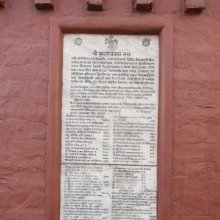Shripada, Śrīpāda, Śrīpada: 5 definitions
Introduction:
Shripada means something in Hinduism, Sanskrit, the history of ancient India. If you want to know the exact meaning, history, etymology or English translation of this term then check out the descriptions on this page. Add your comment or reference to a book if you want to contribute to this summary article.
The Sanskrit terms Śrīpāda and Śrīpada can be transliterated into English as Sripada or Shripada, using the IAST transliteration scheme (?).
Images (photo gallery)
In Hinduism
Shaktism (Shakta philosophy)
Source: Google Books: ManthanabhairavatantramŚrīpāda (श्रीपाद) refers to the “venerable plane (of realisation)”, according to the Manthānabhairavatantra, a vast sprawling work that belongs to a corpus of Tantric texts concerned with the worship of the goddess Kubjikā.—Accordingly, [while describing the Niṣkala Form of Śrīnātha]—“[...] Merged in the Cavity of the Spine, the teacher is the venerable plane (of realisation) (śrīpāda) in the Western (Tradition). (The wise) know him to be the Skyfarer in between (the polarities) of knowledge and ignorance. The supreme teacher whose nature is the Void and is the enjoyer of the Void abides perpetually. The Lord who observes the Vow of Knowledge resides in the End of the Sixteen [...]”.

Shakta (शाक्त, śākta) or Shaktism (śāktism) represents a tradition of Hinduism where the Goddess (Devi) is revered and worshipped. Shakta literature includes a range of scriptures, including various Agamas and Tantras, although its roots may be traced back to the Vedas.
India history and geography
Source: Cologne Digital Sanskrit Dictionaries: Indian Epigraphical GlossaryŚrīpāda.—(IE 8-8), used to indicate ‘the king’; cf. Śrī-caraṇa, etc.; also Tamil Śrīpādaṅgal (SITI), an exalted personage; used as an expression of respect. Cf. Tamil śrīpadatāṅgikaḻ (SITI), vehicle-bearers attached to a temple, as supporting the feet of the god. Note: śrīpāda is defined in the “Indian epigraphical glossary” as it can be found on ancient inscriptions commonly written in Sanskrit, Prakrit or Dravidian languages.

The history of India traces the identification of countries, villages, towns and other regions of India, as well as mythology, zoology, royal dynasties, rulers, tribes, local festivities and traditions and regional languages. Ancient India enjoyed religious freedom and encourages the path of Dharma, a concept common to Buddhism, Hinduism, and Jainism.
Languages of India and abroad
Sanskrit dictionary
Source: Cologne Digital Sanskrit Dictionaries: Monier-Williams Sanskrit-English DictionaryŚrīpāda (श्रीपाद):—[=śrī-pāda] [from śrī] m. Name of various men, [Catalogue(s)]
[Sanskrit to German]
Sanskrit, also spelled संस्कृतम् (saṃskṛtam), is an ancient language of India commonly seen as the grandmother of the Indo-European language family (even English!). Closely allied with Prakrit and Pali, Sanskrit is more exhaustive in both grammar and terms and has the most extensive collection of literature in the world, greatly surpassing its sister-languages Greek and Latin.
Kannada-English dictionary
Source: Alar: Kannada-English corpusŚrīpāda (ಶ್ರೀಪಾದ):—
1) [noun] the feet of a person, deity, which are considered auspicious.
2) [noun] a respectful term used to address or refer a reverential person (as a monk, religious pontiff, etc.).
Kannada is a Dravidian language (as opposed to the Indo-European language family) mainly spoken in the southwestern region of India.
See also (Relevant definitions)
Partial matches: Shri, Pada, Pata.
Starts with: Shri-patantanki, Shri-patantanku, Shri-patarenu, Shri-patatirttam, Shripadadikeshapancashika, Shripadadikeshapanchashika, Shripadasaptaka, Shripatankal.
Ends with: Ramashripada.
Full-text (+6): Ramashripada, Cirpatam, Purushottama sarasvati, Gamagamavinirmukta, Gamavinirmukta, Khakalarka, Kalarka, Parantastha, Agamavinirmukta, Shri-hasta, Shri-carana, Siddhapada, Parameshvara-hasta, Tridhamapada, Garbhasthana, Padanirmukta, Kol, Bodhavya, Anantaka, Navatmadeva.
Relevant text
Search found 17 books and stories containing Shripada, Śrīpāda, Śrīpada, Sripada, Shri-pada, Śrī-pāda, Sri-pada; (plurals include: Shripadas, Śrīpādas, Śrīpadas, Sripadas, padas, pādas). You can also click to the full overview containing English textual excerpts. Below are direct links for the most relevant articles:
Srila Gurudeva (The Supreme Treasure) (by Swami Bhaktivedanta Madhava Maharaja)
Residing in the Abode of Separation (Śrī Jaganntha Purī-dhāma) < [Chapter 2.19 - The Concluding Transcendental Pastimes]
Return to Delhi after Kārtika < [Chapter 2.19 - The Concluding Transcendental Pastimes]
Difference between Aiśvarya and Mādhurya < [Chapter 2.12 - Early ISKCON Conversations with Śrīla Gurudeva]
Dvisahasri of Tembesvami (Summary and Study) (by Upadhyay Mihirkumar Sudhirbhai)
Chapter 7 - Description of Śrīpāda’s glory
Chapter 5 - Narration of Śrīpāda’s incarnation
Lord Dattātreya’s incarnations < [Introduction]
‘Padmabhushan’ Dr. Sripada Pinakapani: A < [April – June, 2008]
A Saga of Yoga as Compassion < [January – March, 2006]
Sripada Subrahmanya Sastri < [July 1964]
Chaitanya Bhagavata (by Bhumipati Dāsa)
Verse 2.5.88 < [Chapter 5 - Lord Nityānanda’s Vyāsa-pūjā Ceremony and His Darśana of the Lord’s Six-armed Form]
Verse 2.19.87 < [Chapter 19 - The Lord’s Pastimes in Advaita’s House]
Verse 2.5.17 < [Chapter 5 - Lord Nityānanda’s Vyāsa-pūjā Ceremony and His Darśana of the Lord’s Six-armed Form]
Brihad Bhagavatamrita (commentary) (by Śrī Śrīmad Bhaktivedānta Nārāyana Gosvāmī Mahārāja)
Verse 2.4.160 < [Chapter 4 - Vaikuṇṭha (the spiritual world)]
Verse 1.1.3 < [Chapter 1 - Bhauma (the earthly plane)]
Sanskrit sources of Kerala history (by Suma Parappattoli)
Tiruvitancode Inscription of Vira Iravi Varma < [Chapter 1 - Historical details from Sanskrit Inscriptions]
2. Balamartandavijaya by Devaraja-suri < [Chapter 5 - Sanskrit Dramas and Campus bearing on Kerala History]
